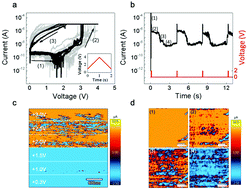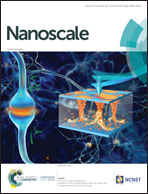Mediation in the second-order synaptic emulator with conductive atomic force microscopy†
Abstract
Memristors have been extensively studied for synaptic simulation and neuromorphic computation. Instead of focusing on implementing specific synaptic learning rules by carefully engineering external programming parameters, researchers recently have paid more attention to taking advantage of the second-order memristor that is more analogous to biologic synapses and modulated not only by external inputs but also by internal mechanisms. However, experimental evidence is still scarce. Here, we explore a BiMnO3 memristor by applying simple spike forms. The filament evolution dynamics, including processes of forming and spontaneous decay, were directly observed by the conductive atomic force microscopy (c-AFM) technique. We propose that the unique conductance state of the BMO memristor is regulated by the oxygen vacancy (VO) dynamic process. We believe this primary result is helpful to improve understanding of the internal mechanisms of the second-order oxide memristor, which exhibits promising application in building selectors, memories and neuromorphic-computing systems.



 Please wait while we load your content...
Please wait while we load your content...